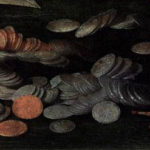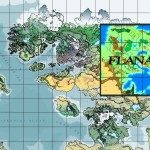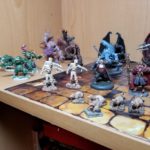This is the simplified monetary system for the world of Asdar. It is simplified because it does not keep track of which currency is in use and assumed a common format of denominations for most monetary systems.
Most monetary systems follow this format and for game purposes are the same. Players can attempt to determine the state of origin for the coins. This adds game flavor and can also be useful in role-playing situations.
Gold Pieces
The gold coin is the standard high denomination monetary unit. It is halved from its standard value in Pathfinder and D&D. This reflects the fact that gold is rarer in the world of Asdar than the standard fantasy rpg. This means that the costs and income given in the PF book are halved. Thus, even though prices are half their gold value, the income and payment one receives is also halved.
Silver Pieces
In the standard monetary system, twenty silver pieces equal one gold piece. In PF, only ten silver pieces equal a gold coin. So, any price in silver pieces is not halved. This of course can lead to confusion. The important thing to remember is that gold is worth twice as much in the world of Asdar. Silver pieces are the only thing roughly the same in value between Asdar and PF.
Copper Pieces
These are also changed in value. In the standard monetary system, one hundred copper pieces are the same in value as one silver piece. This differs from PF where only ten copper are worth a silver piece. Logically, this means that any cost in the PF core rule book given in copper should be multiplied by ten to give its equivalency in the world of Asdar.
I haven’t warmed up to the idea of platinum coinage. In AD&D, platinum coinage was meant to be the ancient coinage of lost empires. There are plenty of lost and fallen empires in the world of Asdar. The Yophenthean Empire loved gold coinage and Yophenthean gold coins are actually larger than standard modern gold coins. They are also very rare and most have been melted down to make modern coinage centuries ago. I could have orichalcum coinage from some forgotten empire many thousands of years ago, but I’m still working that out.
This is the exchange rate across the board:
1 gold piece = 20 silver pieces = 2000 copper pieces.
It’s not simple like 1:10:100 in PF, but it doesn’t offend my sensibilities and I figure if I’m up to using PF, then it’s not undoable.
NOTE: I’ve since looked at my notes and see that 12 asses (Roman pennies) were equivalent to 1 silver denarius. This means that 100 copper pieces to one silver piece is way off. So, I have revised it so that 10 copper pieces equals a silver piece.
1 gold piece = 20 silver pieces = 200 copper pieces.








